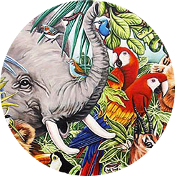
Revisting Swagger
Lately, I am getting a few 'how to do' inquiries on my last Swagger posting. Most questions involve either renaming or sorting REST controllers. I also ran into a few interesting Swagger challenges in the last couple of months. Now that it has been over a year since my lasting posting on Swagger, it is a good time to revisit the subject.
To explore different Swagger customizations, I created an example Github project titled swagger-deepdive. The project consists of multiple REST controllers involving various animals which are part of a menagerie. A menagerie is a collection of exotic animals and birds that are kept in captivity for the viewing pleasure of certain segments of society.
The following controllers are part of the menagerie project: ElephantController, LionController, ParrotController, TigerController, and ToucanController. The backend services are supported by HSQLDB, an in-memory database, and JPA. The project is based on 2.6.1 version of Springfox.
The customization of Springfox and Swagger in the menagerie example can be broadly classified into two different categories:
- Custom Swagger UI: It consists of changes directly affecting the Swagger UI. It involves manipulation of Swagger annotations or HTML pages. Renaming and sorting controllers, rearranging controllers, custom images, and skinning Swagger UI all fall under this category.

Figure 1. Skinned Swagger UI
- Springfox Extensions: Springfox provides hooks, i.e., plugins, to extend Swagger functionality. Creating a Springfox extension primarily consists of writing a Java class extending a known class or interface. An extension usually affects the Swagger model and in some cases UI as well. In the
menagerieproject, a few of the Swagger plugins are explored.
tags:[
{
name:"Classification(phylum=Chordata,
genus=Loxodonta,
species=Loxodonta africana,
family=Elephantidae,
clazz=Mammalia,
kingdom=Animalia,
order=Proboscidea)",
description:"Elephant API"
},
{
name:"A3",
description:"Elephant API"
}
]
Figure 2. Changes to Elephant Swagger model from custom API Listing Plugin
A wiki exists for the menagerie project where I explain each of the Swagger customizations in detail. Incorporating these ideas into your project is a great way to increase the usability of your REST APIs.